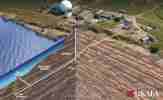| The Shaft Index | Dounreay Index | ||||||||
|
Dounreay |
|||||||||
|
Update 9 October 2004
It was apparent that the water-filled shaft did not meet modern standards for the disposal of intermediate -level waste. Advances in technology meant it was feasible by 1998 to conclude the waste could be retrieved and the facility decommissioned. The waste shaft is one of the great decommissioning challenges in the UK today. The engineering and scientific skills needed to carry out this work to the highest standards of radiological and environmental protection can enhance the international status of the UK in general, and UKAEA Dounreay in particular, in the field of nuclear clean-up expertise. UKAEA has developed a major programme of work to prepare for the retrieval of waste from the shaft. All of this work is subject to stringent regulatory agreement. Key tasks to prepare for the decommissioning the shaft are identified below: This project update focusses on accelerated progress in two areas – hydraulic isolation of the shaft from the geosphere and reinforcement of the plug. Hydraulic isolation
This will also safeguard against the remote possibility of a major leak before waste retrieval begins. At present, the risk of leakage is the main environmental hazard associated with the shaft. Before deciding how to isolate the shaft, UKAEA sought the views of stakeholders on the clean-up of the surrounding rock. The affected area of rock is believed to extend for 300 metres on the seaward side and options range from natural decay of the radioactivity to sealing it in-situ, flushing and excavation. Even though such remedial action would not be implemented until after the shaft is emptied, it is important that UKAEA understands the views of stakeholders today because the chosen method of isolation will penetrate areas of rock that are contaminated. UKAEA discussed the “end state” for the rock with panels of stakeholders and received 32 responses to a consultation document. Some stakeholders felt natural decay of the radioactivity should be allowed, others believed some form of in-situ immobilisation would provide additional reassurance and a small number wanted the rock to be excavated. Some stakeholders expressed the view that a final decision should be taken once the waste had been retrieved from the shaft and more detailed analysis could be carried out. This would mean the “end state” for the shaft would be consistent with future decisions about the “end state” for cleaning up the Dounreay site as a whole. UKAEA welcomes these views. While it accepts that a final decision cannot be taken until the shaft is emptied, the consultation process has enabled UKAEA to conclude that grouting should be its preferred method of hydraulic isolation of the shaft. This would immobilise any activity in a 10m-wide ring of rock around the shaft but does not preclude its excavation at a later date if this was deemed appropriate. The next steps UKAEA obtained planning consent in 2004 for further exploratory boreholes to understand better the radioactive contamination in this region of the rock and this work is scheduled for Autumn 2004. Grouting trials are scheduled for Spring 2005 and a start to civil works at the shaft is planned for Autumn 2005. The grouting operation is expected to take between two and four years to complete.
This will ensure the integrity of the plug in the worst-case scenario of changes in pressure during waste retrieval. The enlarged plug will form part of the grout wall around the shaft. Essential steps to waste retrieval |
|||||||||



